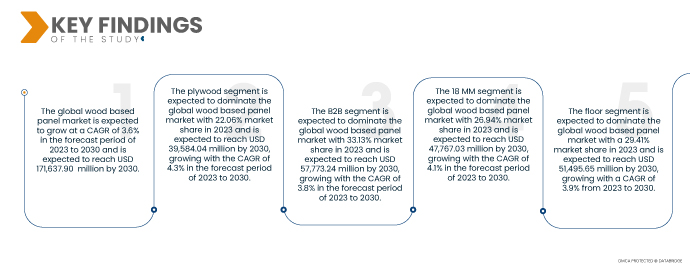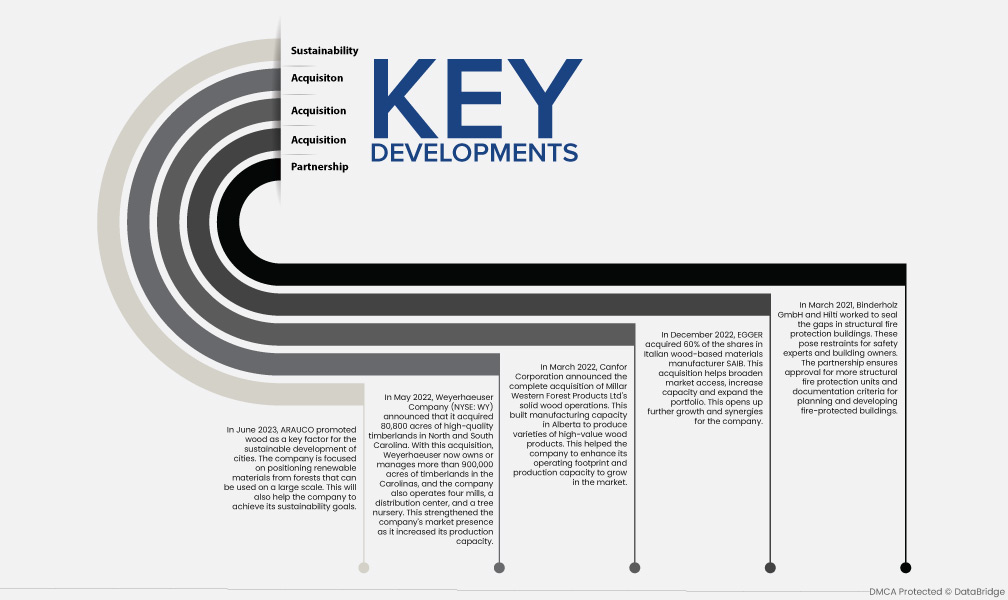Wood-based panels are a common term for various board products with a good range of engineering properties. While some panel types are relatively new on the market, others were developed and successfully introduced more than a hundred years ago. However, panel types with a long history of continuous optimization are still a long way from being fully developed and may always have a chance for improvement. Technological developments, on the one hand, new market and regulative requirements, and a steadily changing raw material situation drive continuous improvements of wood based panels and their manufacturing processes.
Access Full Report @ https://www.databridgemarketresearch.com/reports/global-wood-based-panel-market
Wood-based panels have diverse applications across various end-user industries. In construction, they are used for structural elements, flooring, roofing, and interior paneling. In furniture manufacturing, they are the primary material for cabinets, shelves, and tabletops. The automotive industry utilizes them in vehicle interiors. They are also utilized in packaging, shipbuilding, retail fixtures, and other sectors requiring cost-effective, versatile, and sustainable paneling solutions. Consequently, the growing demand for wood-based panels will likely drive market growth in the projected period.
Data Bridge Market Research analyses that the Global Wood-Based Panel Market is expected to grow at a CAGR of 3.6% from 2023 to 2030 and reach USD 171,637.90 million by 2030. Escalation in the number of investments in the construction of new commercial spaces worldwide for wood based panel market to grow in the upcoming years.
Key Findings of the Study
Low Product Cost Coupled with Superior Properties of Wood Panels, Including Strength and Durability
The wood-based panels are specialty products that provide advanced performance, long-term performance, and enhanced durability, being less expensive to produce and use. The wood-based panels provide an amazing array of possibilities in terms of both structural and aesthetic applications. Because of its affordability, superior performance, and flexibility in design, construction, and renovation, the use of wood-based panels is increasing in residential constructions.
The remarkable growth of engineered wood products in the last decade constitutes one of the success stories of the wood products industry. Research efforts target new composite products, such as bark board (based on wood residues) and strawboard (based on agricultural residues), and new high-performance products from a combination of wood and non-wood materials, such as plastic and cement, to extend wood fiber utilization and product performance.
For instance,
- As per the Food & Agriculture Organization of the United Nations, EWPs (engineered wood products) provide increased flexibility and impetus to the evolution of the design, production, and building of wooden platform-frame structures in North America.
Over the past few years, modular home construction has gained considerable popularity in developed countries, including the U.S. and Canada, as cost-effective construction methods result in a high-quality end product. As the quality and performance of conventional platform-frame construction systems have become better understood and documented, the designers have increased their confidence in using wood platform-frame systems for complex, non-traditional end-uses such as engineered multi-family residential construction. A recent development has been the growth of hybrid construction in which the wood frame system is combined with other systems.
Wood-frame construction has improved dramatically with faster construction, better fiber utilization, less waste, and better quality control. New technological advances in EWPs and connections are positioning the wood products industry to compete successfully in constructing much larger and more complex structures.
Hence, from the above statements, it can be concluded that the low product cost coupled with the superior properties of wood panels, including strength and durability, is expected to promote the growth of the wood-based panel market shortly.
Report Scope and Market Segmentation
|
Report Metric
|
Details
|
|
Forecast Period
|
2023 to 2030
|
|
Base Year
|
2022
|
|
Historic Years
|
2021 (Customizable to 2015 – 2020)
|
|
Quantitative Units
|
Revenue in USD Million and Volume in Million Cubic Meters
|
|
Segments Covered
|
Product (Plywood, Fiberboard, Oriented Strand Board, Cement-Bonded Particleboard, Lumber Panels, T-Beam Panels, Stress-Skin Panels, and Others), Thickness (9 MM, 10 MM, 18 MM, 20 MM, 40 MM, 50 MM, and Others), Distribution Channel (B2B, OEMs, Specialty Stores, E-Commerce and Others), Application (Outdoor Door, Window Trim, Ceiling Wall, Mantel, Floor, and Others), End-User (Residential Building, Commercial Building, Hotels, Villa, Hospitals, School, Malls, and Others)
|
|
Countries Covered
|
U.S., Canada, Mexico, Germany, U.K., Italy, France, Spain, Russia, Turkey, Switzerland, Belgium, Netherlands, and Rest of Europe, Japan, China, South Korea, India, Singapore, Thailand, Indonesia, Hong Kong, Malaysia, Philippines, Australia & New Zealand, and Rest of Asia-Pacific, Brazil, Argentina, and Rest of South America, South Africa, Egypt, Saudi Arabia, United Arab Emirates, Israel, and Rest of Middle East and Africa
|
|
Market Players Covered
|
EGGER (Austria), Boise Cascade (U.S.), West Fraser (Canada), Starbank Panel Products Ltd (U.K.), Dongwha Group (Korea), Kronoplus Limited (Austria), BinderHolz GmbH (Austria), DARE panel group co., ltd. (China), Georgia-Pacific (U.S.), ARAUCO (Chile), Canfor (Canada), Sonae Industria (U.K.), EVERGREEN FIBREBOARD BERHAD (Malaysia), Mieco Chipboard Berhad (Malaysia), Green River Holding Co., Ltd. (Thailand), Kastamonu Entegre (Turkey), PFEIFER GROUP (Austria), Weyerhaeuser Company (U.S.), and Timber Products Company (U.S.) among others
|
|
Data Points Covered in the Report
|
In addition to the insights on market scenarios such as market value, growth rate, segmentation, geographical coverage, and major players, the market reports curated by the Data Bridge Market Research also include depth expert analysis, patient epidemiology, pipeline analysis, pricing analysis, and regulatory framework.
|
Segment Analysis:
The global wood based panel market is segmented into five notable segments based on product, thickness, distribution channel, application, and end-user.
- On the basis of product, the global wood based panel market is segmented into plywood, fiberboard, cement-bonded particleboard, oriented strand board, lumber panels, t-beam panels, stress-skin panels, and others.
In 2023, the plywood segment is expected to dominate the global wood based panel market
In 2023, the plywood segment is expected to dominate the global wood based panel market with 22.06% market share. It is expected to dominate the market as it has heat and chemical resistance and offers all the inherent advantages of the parent wood, plus enhanced properties in its laminated structure.
- On the basis of distribution channel, the global wood based panel market is segmented into B2B, OEMs, specialty stores, e-commerce, and others.
In 2023, the B2B segment is expected to dominate the global wood based panel market
In 2023, the B2B segment is expected to dominate the global wood based panel market with 33.13% market share. The B2B segment is expected to dominate the market as it has good opportunities for wood-based and timber-based panels. In addition, the expansion of B2B via e-commerce sites and wholesalers and a rise in customers are expected to drive the market growth.
- On the basis of thickness, the global wood based panel market is segmented into 9 mm, 10 mm, 18 mm, 20 mm, 40 mm, 50 mm, and others. In 2023, the 18 mm segment is expected to dominate the global wood based panel market with 26.94% market share.
- On the basis of application, the global wood based panel market is segmented into outdoor door, window trim, ceiling wall, mantel, floor, and others. In 2023, the floor segment is expected to dominate the global wood based panel market with a 29.41% market share.
- On the basis of end-user, the global wood based panel market is segmented into residential building, commercial building, hotels, villa, hospitals, school, malls, and others. In 2023, the residential building segment is expected to dominate the global wood based panel market with 21.68% market share.
Major Players
Data Bridge Market Research recognizes the following companies as the major market players in global wood based panel market are EGGER (Austria), Boise Cascade (U.S.), West Fraser (Canada), Starbank Panel Products Ltd (U.K.), Dongwha Group (Korea), Kronoplus Limited (Austria), BinderHolz GmbH (Austria), DARE panel group co., ltd. (China), Georgia-Pacific (U.S.), ARAUCO (Chile), Canfor (Canada), Sonae Industria (U.K.), EVERGREEN FIBREBOARD BERHAD (Malaysia), Mieco Chipboard Berhad (Malaysia), Green River Holding Co., Ltd. (Thailand), Kastamonu Entegre (Turkey), PFEIFER GROUP (Austria), Weyerhaeuser Company (U.S.), and Timber Products Company (U.S.) among others.
Recent Developments
- In June 2023, ARAUCO promoted wood as a key factor for the sustainable development of cities. The company is focused on positioning renewable materials from forests that can be used on a large scale. This will also help the company to achieve its sustainability goals.
- In December 2022, EGGER acquired 60% of the shares in Italian wood-based materials manufacturer SAIB. This acquisition helps broaden market access, increase capacity and expand the portfolio. This opens up further growth and synergies for the company.
- In May 2022, Weyerhaeuser Company (NYSE: WY) announced that it acquired 80,800 acres of high-quality timberlands in North and South Carolina. With this acquisition, Weyerhaeuser now owns or manages more than 900,000 acres of timberlands in the Carolinas, and the company also operates four mills, a distribution center, and a tree nursery. This strengthened the company's market presence as it increased its production capacity
- In March 2022, Canfor Corporation announced the complete acquisition of Millar Western Forest Products Ltd's solid wood operations. This built manufacturing capacity in Alberta to produce varieties of high-value wood products. This helped the company to enhance its operating footprint and production capacity to grow in the market.
- In March 2021, Binderholz GmbH and Hilti worked to seal the gaps in structural fire protection buildings. These pose restraints for safety experts and building owners. The partnership ensures approval for more structural fire protection units and documentation criteria for planning and developing fire-protected buildings.
Regional Analysis
Geographically, the countries covered in the global wood based panel market are U.S., Canada, Mexico, Germany, U.K., Italy, France, Spain, Russia, Turkey, Switzerland, Belgium, Netherlands, and Rest of Europe, Japan, China, South Korea, India, Singapore, Thailand, Indonesia, Hong Kong, Malaysia, Philippines, Australia & New Zealand, and Rest of Asia-Pacific, Brazil, Argentina, and Rest of South America, South Africa, Egypt, Saudi Arabia, United Arab Emirates, Israel, and Rest of Middle East and Africa.
As per Data Bridge Market Research analysis:
Asia-Pacific is the dominant and fastest-growing region in the global wood based panel market during the forecast period 2023-2030
In 2023, Asia-Pacific is expected to dominate the market due to the strong presence of market players in the region and the rise in investment in construction.
For more detailed information about the global wood based panel market report, click here – https://www.databridgemarketresearch.com/reports/global-wood-based-panel-market












